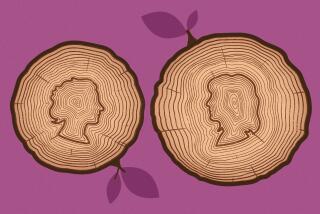The Life and Death of Laurie Dolan : Tragedy: Her death was not news until a tenuous connection was made to alleged Hollywood madam Heidi Fleiss. Now, the drug victim’s family and friends try to pick up the pieces.
Laurie Dolan had eyes like the sky on a brilliant summer day. And when she died last winter, having languished in a drug-induced coma for nearly a day before her glamorous party friends took her to a hospital, her mother demanded an official inquiry.
In many cities, the death of Laurie, a 22-year-old college student from Tarzana with the face of an angel and all the signs of a strong and happy future, would have made front-page news and warranted a criminal investigation.
In Los Angeles, few cared until a tenuous connection to the sleaziest story in this town of sleazy stories made her life and death the stuff of headlines.
Earlier this month, Laurie was momentarily “linked” to alleged Hollywood madam Heidi Fleiss. Tabloid newspapers and television shows speculated on whether she had associated with Fleiss, whether she had been a prostitute, whether she had died because of it. Soon, police decided there was no evidence and the press lost interest.
Now, having seen Laurie’s story dredged up and discarded, her mother has to force herself to go to work. Laurie’s boyfriend, a handsome young professional who refuses to be quoted by name for fear that any association with the Fleiss case will ruin his career, dreams that she is still alive. He says he allowed a multimillion-dollar business deal to wither while Laurie’s face was paraded across millions of television screens.
This is the story of the real Laurie Dolan--beautiful, loving, guileless, something of a party girl, probably not a prostitute--and what happened to her family and loved ones.
“This last week has been a nightmare,” said her mother, Cheri Dolan, her voice breaking. “I’m drained. And I’m furious at the press.”
Laurie Esther Dolan died on March 2, three weeks short of her 23rd birthday. She had overdosed on cocaine, morphine and codeine in the home of Jacob (Cookie) Orgad, an Israeli emigre who frequented the city’s most glamorous nightclubs and liked to throw his weight around.
She started life in Minnesota, the elder of two children born to Paul and Cheri Dolan. When Laurie was a toddler, the family settled in Santa Monica. They moved to Thousand Oaks when she was 10. When she was in junior high school, her parents separated, and Paul, a lawyer, moved to Maui. Laurie went on to attend Thousand Oaks High School, and ran around, said an old friend, “somewhere between the surf crowd and the partyers.”
She was, by all accounts, a beautiful young woman. She was not a stellar student--her grade point average at graduation was 2.95--but she wasn’t a bad one, and she was determined, friends said, to make something of herself.
She wrote poetry and kept a journal, her mother said. She loved to play board games. Mother and daughter were best friends, palling around as if they were contemporaries.
Yet she liked to drink and she used a variety of drugs. Her friends said she was wild--so wild that the gang of girls from Thousand Oaks with whom she had spent most of her high school days stopped seeing as much of Laurie when she moved to Tarzana two years ago and started hanging out with the fast-living, nightclubbing Hollywood “glam” crowd.
She loved the trendy Westside bar circuit--an ever-changing scene where regulars go to whatever club is “in” at the time. When she could, Laurie went to Bar One on Wednesdays, Tripps on Fridays and the Gate on Saturdays--although her boyfriend said she did not get to make the rounds as much as she wanted to.
Some people in the scene were pretty tough characters who toted guns and got into cocaine-propelled fights with one another.
But Laurie believed they all were harmless.
“She loved the limelight,” said Natalie, a friend of 10 years. “She was extremely beautiful and she got a lot of attention down there.”
After Thousand Oaks High , Laurie enrolled in Cal State Northridge, majoring in speech-communications. She wanted to be a television news anchor--or an actress, or a model.
She held two jobs--as a telephone saleswoman for a stock broker and as a waitress at the Sagebrush Cantina in Calabasas, a sawdust-on-the-floor kind of place where suburbanites in leather hang out with bikers and spandex-clad biker wanna-bes on Sunday afternoons.
“She would study while I worked at night,” her boyfriend said. With his shoulder-length blond hair, slicked back for business meetings, and an affinity for real estate, he is a classic young Southern California entrepreneur: the kind of guy who can work 24 hours straight on a business deal and then go out for a run.
“Our lives were extremely balanced,” he said. “We would go out once, maybe twice a week.”
But an ambitious young entrepreneur has to work a lot. And a glamorous 22-year-old who enjoys getting free drinks from rich men likes to go out.
So for the last two months of her life, her boyfriend said, Laurie started hitting the clubs without him, seeing her buddies early in the evening and then meeting up with him later.
That is why he was home--and she was out partying--the night she overdosed.
The other people with her that night--a Sagebrush waitress, Orgad and two other friends--will not talk about what happened. Orgad’s attorney, Terrence Roden, would only say that his client “thinks it was a tragedy” that Laurie died.
“The last time I saw her, she was sitting on the edge of the bathtub, shaving her legs and talking excitedly about how this person ‘Cookie’ was going to take her and a couple of friends out to dinner at Tatou in a limousine,” said her roommate.
Because her father was unexpectedly in town and staying at her condo, Laurie phoned later from Tatou to see how he was doing.
At some point, according to the coroner’s report, the group went back to Orgad’s West Hollywood condo, where they continued partying until they “passed out.”
The next morning, everybody woke up except for Laurie, according to the coroner’s report. When she still was not up by 5 p.m., Orgad took her to the emergency room at Cedars-Sinai Medical Center.
She was probably already brain dead, doctors told the family, although if she had been brought in sooner, she might have had a chance. She had cocaine, morphine, codeine and the sedative meprobanate in her system.
Doctors told the family that the morphine might indicate the presence of heroin because both are opiates and can break down into similar compounds in the body.
Three days later, Laurie was removed from life-support and died. Her family pressed for an investigation: Maybe she did not know the coke was cut with heroin, a drug she had sworn never to try. Maybe somebody slipped her something. Maybe there was negligence in her friends’ failure to bring her to the hospital earlier.
But the coroner’s verdict was accidental death, and that was the end of it.
Until some enterprising reporters--helped by the Hollywood gossip circuit--figured out that Orgad was an associate of Fleiss.
Then all hell broke loose.
The Los Angeles County Sheriff’s Department, under pressure from reporters, put out a press release saying that Laurie’s death was under investigation, and police sources said her case was being scrutinized in light of the potential Fleiss link.
Never mind that the sheriff’s deputies and police soon recanted, saying there probably was not a connection. Or that Frank Mackey, a private investigator hired by the family, said he has discarded the notion that she was a prostitute, despite persistent rumors in the club scene before and after the Fleiss connection hit the press.
Laurie had hit the news.
And there she stayed. The story of her death appeared in newspapers and on tabloid TV shows for more than a week, always linked to Fleiss. Some reporters were coy, reporting only that there might be a connection to Fleiss but adding there was no evidence Laurie was a prostitute. Others went further.
“The ‘Hollywood madam’ scandal turned sinister yesterday,” reported the New York Post on Aug. 9, adding that sources said Orgad “allegedly recruits young women” for Fleiss, allegations Orgad denied.
The Sunday Telegraph in London compared the case to a 1940s murder mystery, and said Laurie might have been an “associate”--in quotes--of Fleiss. Tabloid TV shows ran a videotape of her cavorting at a party in Palm Springs, and sandwiched her story between segments on admitted prostitutes.
And Laurie remained a fixture on tabloid TV reports for at least a week after police said they had no evidence to link her to Fleiss.
To a degree, what happened to Laurie Dolan can be seen as a catastrophic crash between two sides of her nature: not that she was leading some kind of double life, but that somehow her naivete collided with her desire to walk on the wild side.
The duality cropped up again and again. She kept inviting her old high school friends to join the party scene. She tried to make friends with the professional cynics who used to play jokes on her in the clubs, taking advantage of her gullibility. She always tried to smooth over the spats that were bound to crop up in the petty, competitive nightclub world.
“Even at the funeral, it was really kind of weird,” said a high school friend. “Because there was her casket, all the people from her hometown, boyfriends, mother, all on one side. And on the other side, it was total Hollywood, party animals.”
Whatever the reasons for Laurie’s death, her family and loved ones are alone in ways that go beyond having lost somebody dear to them.
They are increasingly isolated, forced to block out the harsh, repeating gossip about Laurie, and trying to hang onto their memories of the young woman they knew.
Well-meaning friends, figuring that Laurie must have been a prostitute, keep advising her boyfriend to get an AIDS test. Potential buyers of a house he owns in Woodland Hills have recognized Laurie’s picture from “Hard Copy.”
And Cheri Dolan--overwhelmed with the crush of media and the cruelty of the accusations--has stopped answering her phone. She’s going out of town for a while, back home to Minnesota.
She talks about her own mother, who died when Cheri was 12. And she remembers her daughter her own way, with a fierce loyalty that suffers no reporters, no gossips, no innuendo.
“When she smiled,” Cheri Dolan said, “it was like the sun came out.
“That’s all you need to know.”
More to Read
The biggest entertainment stories
Get our big stories about Hollywood, film, television, music, arts, culture and more right in your inbox as soon as they publish.
You may occasionally receive promotional content from the Los Angeles Times.










